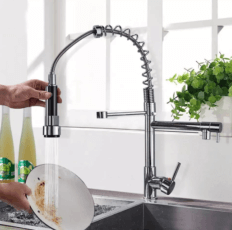Understanding Low Water Pressure in One Faucet Only


Have you ever noticed that the water pressure in one faucet is lower than the other faucets in your home? It can be frustrating, especially when you need to rush through a task or want to take a quick shower. But why is it that only one faucet has a low water pressure? In this article, we will discuss some of the most common causes of low water pressure in one faucet only and how you can fix it. We will also discuss how commercial automatic faucets are affected by low water pressure.
Clogged Aerator
The aerator is a small component at the end of most faucets and showers. It consists of a mesh filter that prevents sediment from entering and may have an additional screen with tiny holes to reduce splashing. If these get clogged with sediment, debris, or dirt, they can reduce water flow and cause low water pressure in just one faucet. The easiest way to check if your aerator is clogged is by unscrewing it from the spout and cleaning out any build-up with vinegar and water.
Leaking Pipes
If your pipe system is leaking somewhere along its length, it could cause low water pressure in just one particular area—usually where the leak occurs—as there won’t be enough pressure to reach other outlets properly. To determine if this is causing your issue, try turning off all other taps around your house and see if the problem persists; if not, then you know there’s a leak somewhere in your pipes that needs to be fixed.
Incorrect Fixture Combination
This usually occurs when too many fixtures are connected to one pipe line or when two different sizes of pipes are connected together; this reduces the flow rate of each fixture even though they’re all getting equal amounts of water from the same source. To resolve this issue, make sure all fixtures are connected correctly before attempting any repairs yourself as incorrect installations can lead to further complications down the road.
Automatic Faucets
Automatic faucets store provides rely on sensors that detect movement near the tap’s nozzle and response by releasing a specified amount of pressurized water for a set period of time; however, since these sensors require power from an AC outlet or battery source, they too can suffer from low water pressure due to electrical issues or faulty wiring connections. If this happens with your automatic taps, check for any loose wires or faulty components before replacing them entirely as this could save you time and money in the long run!
Read More of our Blogs: Latest Government Jobs & Govt Jobs and Pakistan Jobs
FAQs
How do you fix a low water pressure faucet?
The first step is to identify the cause of the low water pressure. Common causes include a clogged aerator, leaking pipes, or incorrect fixture combinations. Once you have determined what’s causing the issue, you can then take steps to fix it. This could involve cleaning out your aerator, fixing any leaks in your pipe system, or ensuring all fixtures are connected correctly.
How do you fix uneven water pressure?
Uneven water pressure in your home can be caused by a variety of factors, such as clogged aerators, leaking pipes, or incorrect fixture combinations. If this is what’s causing the issue, then follow the same steps outlined above to resolve it. Additionally, you may find that adjusting the main valve for your water supply can help even out the pressure in your home.
Why does only my kitchen sink have low water pressure?
Low water pressure in just one sink can be caused by a variety of factors, such as a clogged aerator, leaking pipes, or incorrect fixture combinations. To identify what’s causing the issue and take steps to resolve it, follow the same advice outlined above. If none of these solutions seem to work, then you may need to call a professional plumber to take a closer look at the issue.
Conclusion:
Low water pressure in one faucet only can be caused by a variety of different factors such as clogged aerators, leaking pipes, incorrect fixture combinations and even problems with automatic taps powered by electricity or batteries. Before attempting any repairs yourself, it’s important that you first determine what’s causing your issue so you don’t end up wasting time and money on unnecessary steps!




